Heating in greenhouses in winter is arranged by gardeners who are interested in getting fresh vegetables all year round. To heat the premises, infrared heaters, heating cables, stoves or heat guns are used. There are also other heating methods. Equipment for them can be quickly and easily installed. These include: lamps for heating, gas heating pipes underground or a helium collector. The cost of work will decrease by 2-3 times if the installation is carried out without attracting hired workers.
Content
Material for construction
Capital greenhouses are built on the foundation if the owner has a large family or intends to grow vegetables for sale. Such pavilions are built from a strong metal frame, and the walls and roof are made of glass panels. This construction will cost not cheap, but will pay off in 3-4 years.
Less expensive but equally effective are polycarbonate structures. In special stores you can buy ready-made greenhouses. They differ in types or assembly methods. Heating, both the first and second design, will be more expensive than heating small greenhouses built from improvised materials.
Such buildings are built on a wooden or clay foundation. The material for their installation are old window frames, pieces of polycarbonate or combined coatings. Small-sized greenhouses do not require large expenditures for a heating device.
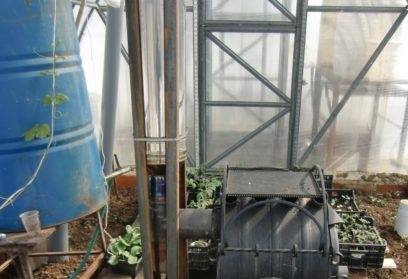
How to keep warm
The reasons why the air temperature drops in the greenhouse must be eliminated before the onset of the heating season. In autumn, you should carefully inspect the entire building. Identify and eliminate design flaws.
| Causes | How to fix |
| Frame or coating damage |
To dismantle worn or rotten wooden beams and racks and replace them with new elements. Remove sheets of polycarbonate and glass with cracks, repair small scratches with special means. Carefully seal joints between frames and glass.
|
| Deterioration of the wooden foundation | The wooden base, which has fallen into disrepair, needs to be disassembled and a more reliable foundation made of brick or concrete |
| Exposure to cold wind or lowering air temperature |
Install winter greenhouse closer to the walls of the main house or another building (barn, garage). To erect a hedge, the height of which will not block the light necessary for plants in the daytime. Apply additional insulation from a thick film or polycarbonate sheets with a thickness of not more than 8 mm |
Types and arrangement of heating systems
There are different ways of organizing heating in greenhouse pavilions. Some of them are more complex, others are simple and do not require special skills. Heating of small rooms can be arranged by installing several small-capacity heating appliances. Larger greenhouses require more efficient heating systems.
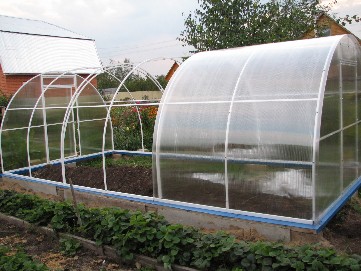 You may be interested in:
You may be interested in:IR heating
The greenhouse is heated by an infrared heater using electric, gas or diesel installations that emit infrared rays. Heating elements in them are of the following types: ceramic, carbon or heating elements. They also differ in shape. These are lamps, tapes and panels that heat the surface of the soil.
Manufacturers produce mobile or stationary infrared devices. Portable devices are easy to install. They can always be moved to a convenient place. You can change their position in a few minutes. Strengthen or reduce the effect of heat on plants with the help of temperature regulators. Fixed lights are installed on the ceiling, walls, skirting boards or suspended on special brackets.
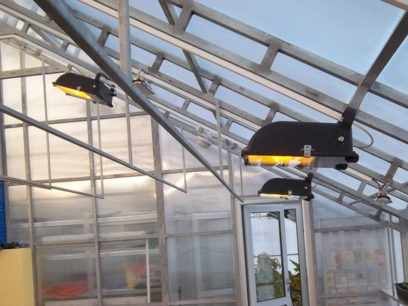
The power of devices is determined by two indicators - the heating temperature (from 600 to 1000 ° C or more) and the infrared wavelength (long, medium, short). Install lights, following some rules:
- the heater should be at least 1 m from the plant. As the seedlings grow, the lamps gradually raise or decrease the power of the lamps;
- place the devices at least 50 cm apart. In large greenhouses, you can place lights in a checkerboard pattern;
- It is more efficient to use light gas infrared devices for heating large winter pavilions, and use dark emitters in small greenhouses.
| System benefits | disadvantages |
| Uniform heating of a specific site | Increased price of IR equipment |
| Reduced area heating time | The risk of acquiring counterfeit products |
| Energy saving up to 70% | Difficulty in accurately calculating the number of appliances needed to heat a particular room |
| Silent operation of devices | — |
| Oxygen is not burned, dust does not rise up, normal humidity is maintained | — |
| The risk of spread of fungal diseases and the propagation of pests is reduced | — |
| Possibility to use flat or spherical devices | — |
| Small size, high fire safety | — |
| Easy installation with self-installation | — |
Electric heating systems
This group of devices includes: electric heaters, convectors, boilers and cables. The availability of electricity and ease of installation allow gardeners to organize electric heating in large and small rooms with their own hands.
Installation of cable heating in a greenhouse will cost inexpensively, and every gardener can afford to equip it:
- The platform is leveled and ground is removed to a depth of 20-30 cm (shovel bayonet).
- Sand is poured into the recess with a layer of 5 cm, leveled and compacted.
- Lay a protective metal mesh.
- A heating cable (zigzag) is placed on top.
- Cover the second grid and cover with a layer of sand.
- The last layer is a fertile substrate up to 30 cm high.
The bed is obtained slightly raised above the surface of the site. Around the perimeter of the beds they make a low fence made of improvised materials: boards, small cross-section bars or bricks.
Convectors and other heating devices are installed near the walls, but not closer than 0.5 m, so that the polycarbonate coating does not melt.
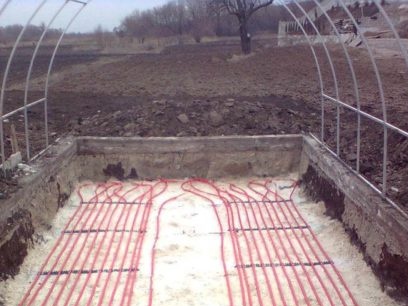
Electric boilers can be used if there is a water circuit in the greenhouse. This is a convenient heating system, but additional funds will be required for laying pipes if they have not been installed before.
| Benefits | disadvantages |
| Low cost of equipment | High cost of electricity |
| Easy to install and operate | Lack of conditions for connecting devices of the required power (remoteness of power lines) |
| Ubiquitous availability of electricity | — |
| Fast and stable warming of air and soil | — |
| High, modern automation system | — |
Economical heating methods
Not all gardeners have enough money to install expensive heating systems. There are quite cheap, but quite effective devices. They can be mounted with your own hands. These settings include:
- stove stoves that quickly heat the air in the room, they are lightweight, they can be transported, installed in a specific place;
- conventional stationary brick stoves, to which pipes are connected to supply warm air to the greenhouses. With this option, you can use a fire, diluted near and a pipe directed into the room;
- air heating of the greenhouse can be arranged by installing 2-3 small generators or fans that feed a directed stream of heated air to the plants;
- heat guns or pumps are not so economical due to the high cost of equipment, but they heat large greenhouse pavilions;
- film IR heater is used to warm the soil in the beds. The film is laid to a depth of 30-40 cm, insulated with a net and covered with fertile soil. The method is simple but effective for a long time.
Underground gas heating device
Natural gas is cheaper than electricity, therefore, equipment running on this fuel is more profitable to use for heating greenhouse pavilions. In many country houses and cottages, gas boilers are installed, a gas heating system from pipes is laid.
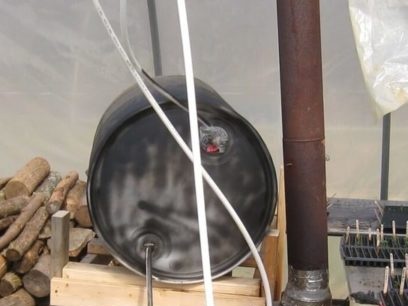
Owners can lay the pipeline themselves and connect it to a centralized system. Specialists in this matter are necessary only for checking the track and tie-in. Owners can do the main work on laying gas pipes on their own:
- Dig a trench to the size of a heated area with a depth of about 50 cm.
- Pipes are laid in the form of a "snake" and connect them with corner elements.
- The diameter of the pipeline for direct supply should be larger than for the return of water.
- Under the supervision of a specialist, the pipeline is connected to the boiler and the entire system is checked for leakage and the degree of heating. Using the controller, set the required heating temperature.
- The trench is sprinkled with removed soil, a layer of fertile soil 30-40 cm high is laid on top.
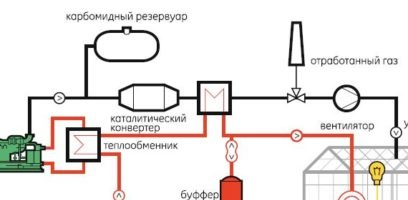
Pipes can be used both metal and polyethylene. Experienced gardeners recommend laying PVC pipes under the greenhouses. They are not susceptible to corrosion. They do not need to be additionally insulated, like metal pipelines. Both of them will last for a long time without repair, if the necessary requirements for installation are observed (see video).
Solar heating
Electricity consumption for heating greenhouses can be reduced. For this, collectors powered by solar energy are used. The main types of such devices include: vacuum flasks, panels that absorb heat and air collectors. These devices differ in design and principle of operation.
| Type of | Design | Principle of operation |
| Tubular water heater from vacuum flasks |
Glass vacuum tubes. The heat exchanger is a hollow copper rod. Heat distributor. Sun reflector |
Provides warmth in the winter at temperatures up to - 50 ° C by 15-20% |
| Heat-absorbing panels |
The metal plate is painted with a special paint that absorbs solar heat. Bottom is an aluminum or copper heat exchanger |
Thermal energy is transferred to storage tanks and heats water to 40 ° |
| Air collectors | The bottom of the device is covered with a special paint that absorbs the thermal energy of sunlight | When the sun's rays affect the paint, heat is released. Heated air is forced into the room by fans. |
Use of such equipment is advisable in southern regions with mild winters and longer daylight hours. Installations powered by solar energy are less effective in areas where frosts are below -25 ° in winter. At these temperatures, they freeze and stop working normally.
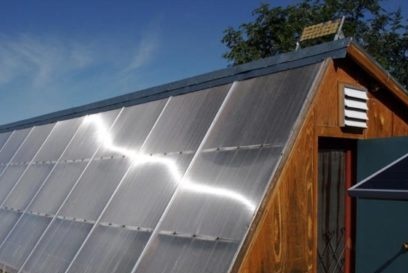
| Benefits | disadvantages |
| Cost savings for other types of heating of greenhouses, Up to 50% of all heat comes from free thermal energy of the sun | The need for initial investment |
| Additional heating of water for watering plants | Dependence of the operation of devices on the duration of daylight hours |
| The use of air collectors allows you to normalize the humidity in the room | In winter, heat production is reduced by 20-30% |
| Quick payback in 2-3 years |
— |
Greenhouse owners are ready to invest in the installation of heating systems. They see this as a real benefit. In winter, the family is provided with fresh vegetables, and some of the products can be sold on the market and earn income. If you do simple work with your own hands, the cost will be halved.

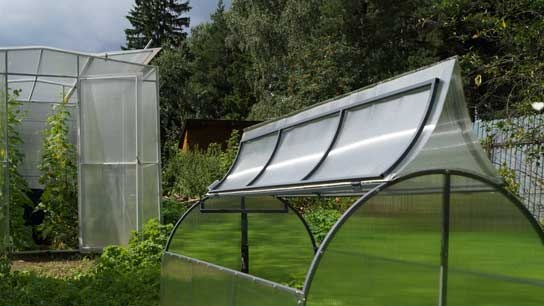 Why is a greenhouse open top?
Why is a greenhouse open top?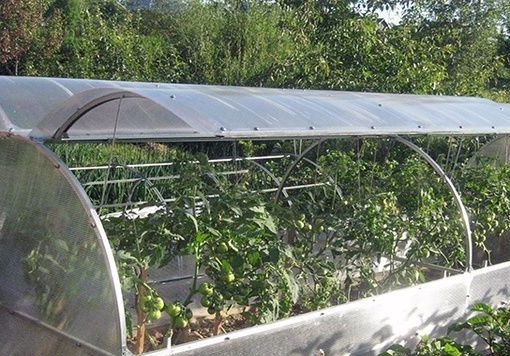 Greenhouse "Butterfly", is it worth it?
Greenhouse "Butterfly", is it worth it?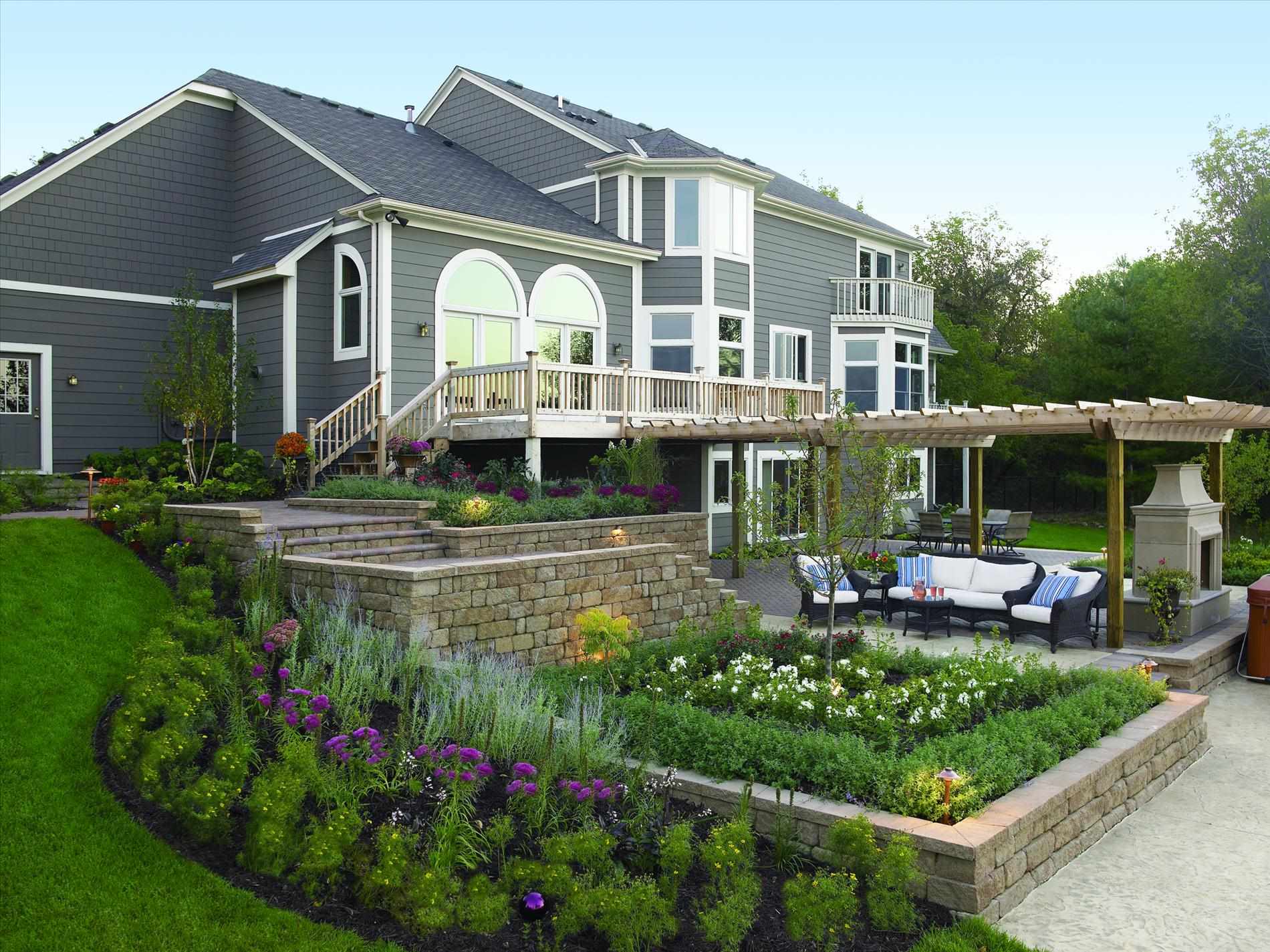 Do-it-yourself landscaping of an area of 8 acres: features of planning and zoning
Do-it-yourself landscaping of an area of 8 acres: features of planning and zoning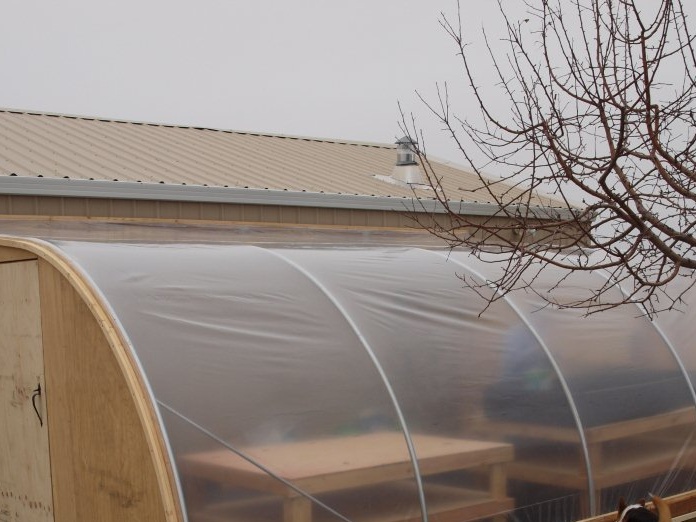 Shed greenhouse, pros and cons
Shed greenhouse, pros and cons